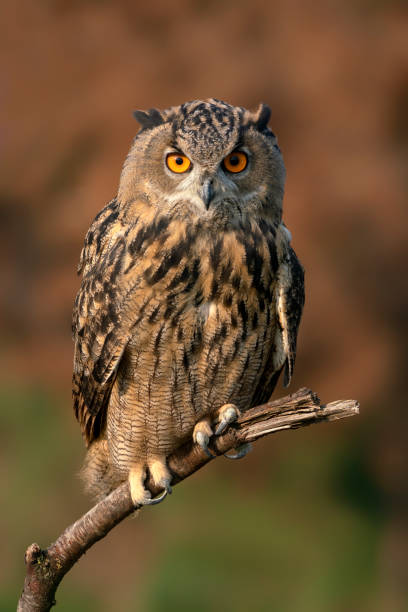ANIMAL: Eurasian Eagle Owl Bubo bubo Type of Animal: Owl Habitat: Woodlands, mountains, forest, grasslands, semi-desert, desert, desert edges, riverbeds, rocky areas, cliff areas, rocky canyons, farmland, steppe, parks/park-like settings, ravines, alpine meadows, steep slopes, mountainous forest edge, lowlands, riparian areas/areas near rivers, wetlands, agricultural areas, towns, villages, ski resorts, marshes, swamps, shrubland, suburban/urban areas, pastures, areas near lakes, caves, quarries, scattered tree areas, thickets Location(s): Eurasia from W Europe all the way to Japan as well as N Africa Appearance: One of largest owls in world, noticeable ear tufts, vertical chest striping, orange/red-orange eyes (eyes often yellow-orange in Afghan/Turkmenian/Himalayan/Steppe/Spanish subspecies), upper feathers/body ranges from brown-black to tawny-buff to pale creamy gray w/ dense freckling on forehead/crown, lower breast/belly feathers range from creamy brown to tawny buff to off-white w/ variable dark wavy barring, black feet/bill, tawny-buff to grayish-brown facial disc w/ black-brown speckling, whitish chin/throat w/ brown central streak. European subspecies darkest (especially Scandinavian birds)/most richly colored. Western Siberian subspecies palest. Western Siberian/Eastern Siberian/Yakutian subspecies largest. Afghan subspecies smallest. Females larger than males. Food/Diet: Mammals up to size of small deer, birds up to size of swans, eagles, cranes, & bustards, reptiles, amphibians, fish, insects, crabs, carrion Status in Wild: Stable Conservation: Breeding in zoos & wildlife centers. Population monitoring in parts of range. Reintroduction programs in parts of range. Lifestyle: Solitary, monogamous pairs, or family groups comprising monogamous pair w/ 1-2 offspring & occasionally, a juvenile, subadult, or adult nonbreeding helper. Additional Info: Called: Male: Cock Female: Hen Young: Owlet Group: Parliament Weight: Male: 3.3-6.6 lbs Female: 3.9-9.3 lbs Gestation: 4-5 weeks Life Span: 15-20 years in wild, 40-60 years in captivity Height: Male: 2 ft Female: 2.5 ft Body Length: Male: 2 ft Female: 2.5 ft Tail Length: Male: 10 in Female: 12 in Main predators of adults are wolves, bears, large eagles (sometimes owls overpower & eat eagles), lynx, & large foxes (owls often kill foxes in fights to the death). Martens, badgers, other raptors, cats, corvids, pigs, raccoons, raccoon dogs, & foxes prey on owlets. Males have a 5.1-5.7 ft wingspan, females have a 5.5-6.3 ft wingspan. These owls are either nocturnal or crepuscular. While stable, these owls sensitive to disturbances. Also suffer from persecution, hunting, poisoning, & vehicle/wire collisions. Females lay 1-6 eggs, though larger owlets may kill smaller siblings. Owlets leave parents at 8-12 months & mature 8-12 months later. Fun Fact(s): These birds are sometimes used in falconry & pest control. In June 2007, owl landed in Helsinki Olympic Stadium during European Football Championship qualification match between Finland/Belgium, interrupting game for 6 minutes.
